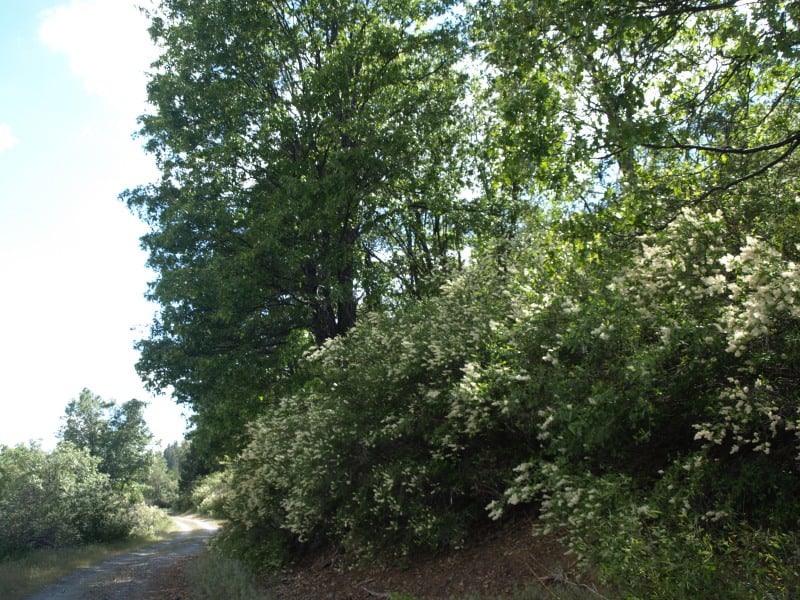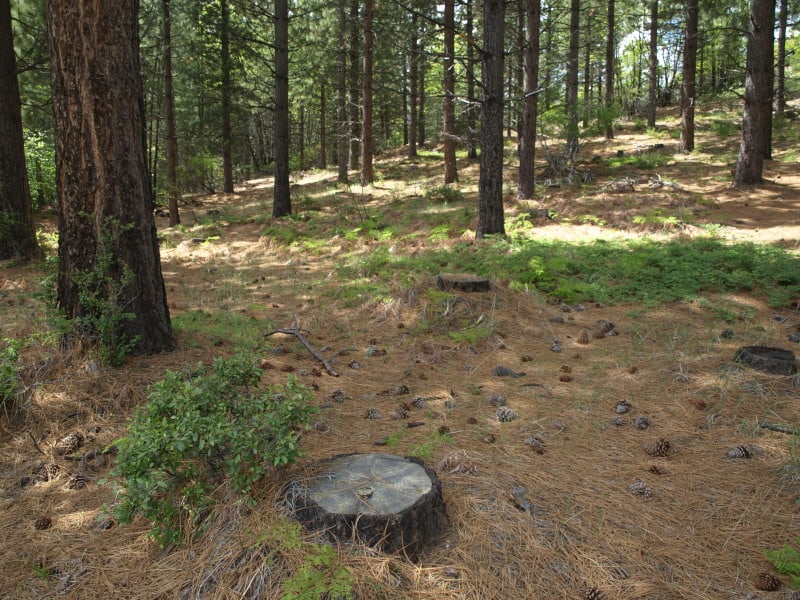The media does like to sensationalize events like the Rim Fire, often implying that the lands have been “destroyed”. The Rim Fire is so huge and burned across so many differing kinds of vegetation that you cannot summarize too much. Even my own “sampling” from the access roads doesn’t cover very much of the impacts and effects of a 250,000 acre wildfire.
Much of the wildfire burned in plantations generated from previous wildfires. Here is an example of one of those plantations that wasn’t thinned. I can see why it wasn’t but, maybe a “pre-commercial thinning” kind of task could have been included into one of the other commercial plantation thinning projects that I worked on, back in 2000.
In the same area were blocks of land that were left for “Mother Nature”, after the early 70’s Granite Fire. Here is what a 40 year old brushfield looks like. Those blocks are choked with deer brush, whitethorn and manzanita, with very few conifers, and fewer oaks than the “natural stands” (as they called the unburned portions).
As you can see, sometimes there is a fine line between a total plantation loss and one that has survived a wildfire. This is one of the thinned plantations, near Cherry Lake.
Here is another example of an “old growth” brushfield. While this one didn’t burn much, there are many examples of them burning at moderate to high intensities. Looking at Google Maps, I can find examples where the flames from the brushfields were pushed into the thinned plantations. The Forest Service should be treating those old brushfields with prescribed fire, instead of “whatever happens”.
This unburned stand, within the fire perimeter, is a good example of the work we did back in 2000. I don’t really know of any other reason why this large patch, near Cherry Lake, didn’t burn
The Clavey River, long-cherished by the local eco-community, acted like a conduit for the Rim Fire, as it burned so many acres in just one day. However, you can see that the intensity and damage is rather minimal. There is a fork in the river, down there, and the main fork of the fire went up that way, finding more conifers to burn. (It also found the big block of Sierra Pacific Industries lands.) I found it very interesting that the isolated pockets of Douglas-firs had very high mortality, but only a low-to-moderate intensity.
Here is one of those pockets, alongside the Clavey River. In the past, this kind of pocket would be thrown into a large helicopter salvage project.






Thank you for sharing your photos of different post-fire situations on the Rim Fire!
Precommercial thinning can be a mixed bag when it comes to fire. My experience comes from the Biscuit Fire in southwestern Oregon – another 500,000 acre fire. In an area that large, a variety of conditions occur post-fire. In one case, there was a plantation that looked similar to your first picture – about the same age/size, but primarily Douglas-fir. It had been precommercially thinned. There was a genetics test plantation in the middle of the plantation that had not been thinned. The genetics area survived the fire – the plantation did not, presumably due to slash from the non-commercial thinning, but perhaps also due to the difference in microclimate?
There were also some interesting effects from the 1988 Silver Fire, a 100,000 acre fire on the north end of the Biscuit Fire (and some of it reburned in the Biscuit Fire). That area has a lot of sprouting evergreen hardwoods and prior to the 1980s, a lot of that vegetation was sprayed with herbicides after replanting. There were lots of research plots for brush control as well. After the Silver Fire, they noted that the plots with brush control had 100% conifer mortality, and the plots without it did not – but in that case, the brush is not very flammable (compared to chapparal vegetation in the Rim Fire area?).
Some parts of the Groveland RD has tree ring data showing 13 fires in the last 100 years. There is a spike in historic wildfires at that point in the Sierra Nevada, possibly due to the steepening landscape of the western side. That also allows the fire-adapted brush species to dominate. The local Indians expertly crafted their forests to be shady and long-lived.
Yes, I also worked on the post-fire Biscuit salvage. There are so many variables, even within one fire. I saw incinerated “owl circles” and green un-thinned plantations, almost side by side. I do remember seeing plenty of additional die-back, due to bark beetles, especially along the road to Babyfoot Lake.
Most of the really bad impacts happened up in Yosemite National Park. So much old growth is now dead, and awaiting the next inevitable re-burn. Google Maps is a great tool to see those remote areas. We really should be studying the effects of “letting nature take its course”, in this particular situation, in the National Park.
Larry – I was living in Dorrington and working in the woods near the Calaveras District when the Complex fire occurred in 1987. A few years later I was a peon seasonal for the Mi-Wok District. You are correct about the magnificent diversity of the Stanislaus and I hope your brief notation suggesting the Agency put some time into thinning the brush to release more conifers. There was some old growth left on the Stan but characteristic of trying to maintain a middle way, I also heard retirees from Louisiana Pacific and one of the area’s trucking contractors revisiting the glory of the one-log load. If we want a healthy forest we have to anticipate fire. The devil has always been the money. Replanting plantations isn’t going to do it. Increasing range fees to work on improving hydrology and raising the water table to fully hydrate the vegetation has been shot down repeatedly. Convincing campers that you can camp out happily without a fire is left to the future. All the thinning, pre-commercial or industrial is not going to change the reality that most of our fires are caused by campfires and vehicles in grasses when not outright arson. It’s a complex issue – multiple use management, human nature and denial, weather and at what point a system’s fire ecology is over run by unnatural human caused fires. Perhaps restoration ecology has room for restoration resorts – come experience the sweat equity of loving a forest?
I can not express strong enough, the importance of managing our remaining forested lands by identifying the unique communities that make up the forest mosaic and developing management prescriptions that encourage improvement of the diversity that originally created these unique communities. Massive silvacultural treatments, large wild fires and other catastrophic events are rapidly destroying the diversity that once existed. Great advancements have, and are being made in the technology associated with the science of forestry, increased production per acre, genetically altered species that are resistant to disease, high tech tools to collect data, etc. This is great but if we don’t soon change our focus on what we take from the forests to how to create healthy diverse forest communities, we will loose the battle. The natural resources from the forests are the by-product of proper management, not the goal!
Shouldn’t we also focus on what we are leaving in our forests, instead of preserving unnatural conditions? The California Indians promoted the creation of large diameter pine forests, using only fire as a tool. We should be able to do better but, right now we are pretending that a 21 inch tree should be “sacred”, considered to be “old growth” and off limits to management. The Groveland RD used to be known for its huge sugar pines. Now it is known for its monstrous fires.